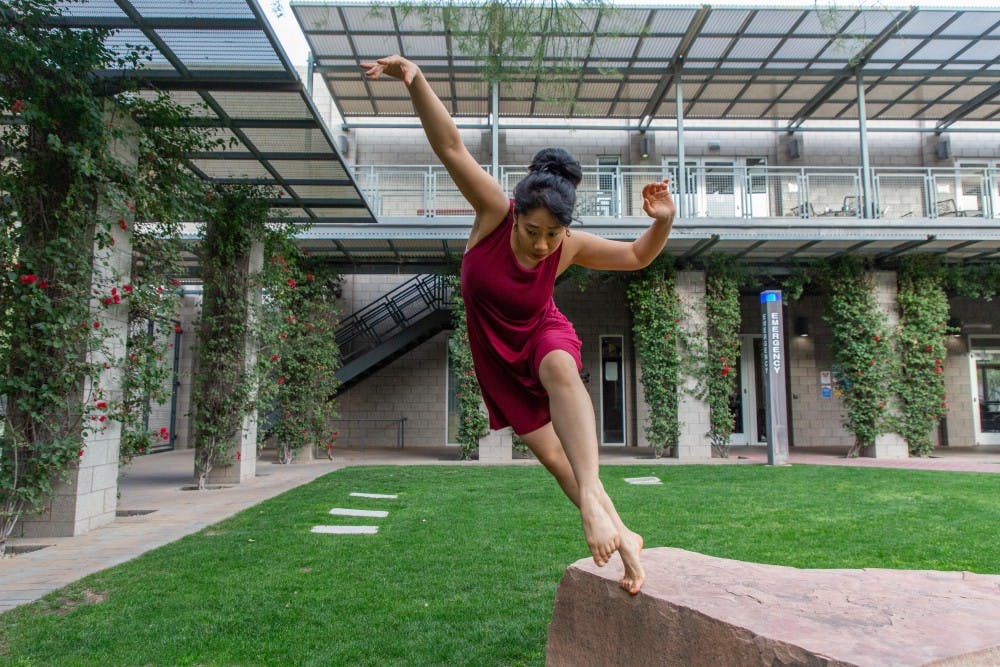With Asian students comprising a small percentage of ASU's student population, Asian-American graduate student Angeline Young found herself feeling out of place when she first arrived in Tempe.
Angeline Young, who came from San Francisco to complete her master's degree in dance at ASU and a doctoral degree in international letters and cultures, said it was difficult to adapt to the new environment at a school where the student body largely did not reflect her background.
But one of the ways she grounded herself in the new community was through dance.
"We all experience art in different ways, but it is a universal portal through which people can find self expression and a sense of place in the world," Young said.
Now, through her research at ASU, Young is hoping to expand this idea to explain through dance how the Chinese diaspora has shaped Italy, diving into how Chinese bodies use space and create community in the country.
Young is embarking on an ethnographic study through a program in the School of International Letters and Cultures, in which she seeks to tell the story of Chinese people who settled in Italy. Her study involves observing, participating, interviewing and documenting everyday Chinese practices in Rome.
As a dancer, Young said she tries to find a unique approach to academic research. Dancers, Young said, see the world differently because they feel it through their body. This body awareness is called kinesthesia, the body’s ability to sense movement.
“I applied kinesthesia as a research lens to examine the movement of ethnic Chinese diaspora in Italy,” Young said. “My research asks, 'Can we see Italy as a legendary oasis of food, family and culture and an international crossroads for migrants who are reshaping Italy's cultural landscapes?'"
Even though the Chinese population in Italy is one of the most established cultural diaspora groups in Italy, she said few people know much about it and are in fact surprised by its existence.
Rashad Shabazz, an associate professor of justice and social inquiry in the School of Social Transformation and a co-chair of Young's dissertation, said that while the dynamic Young describes in the Chinese population in Italy is something seen around the world, her research tackles a population that’s underrepresented while still reflecting the contemporary social cultural landscape.
Shabazz said the tension between two cultures, between immigrants and those native to the land, is a theme that has been explored in various countries all over the world.
“It doesn't mean the negation of Italian ethnicity, history and culture,” Shabazz said. “It means that Italian history, culture and ethnicity will be part of a broad landscape of different peoples that will form the fabric of the country."
He said that the interaction between immigrants and the native Italian population helps Italian culture remain productive, engaging and expansive.
In her study, Young is studying how Chinese immigrants changed what it means to be Italian today, how their narrative can help bring understanding to the European migrant crisis and more.
She said that regardless of whether or not they’re immigrants, or fit the stereotypical Italian image, Chinese immigrants in Italy still contribute to cultural production through offering tangible goods.
“In the face of these legal challenges, non European migrant communities struggle with issues of cultural belonging in an Italian state that has recently administered some questionable policies that encumber the entry of migrants but also surveil existing ethnic migrant businesses," Young said.
Young said her goal of studying the Chinese ethnic community in Italy comes from her interest in interculturalism as a child of Chinese refugees who speaks Italian and Chinese.
She said she hopes that her storytelling and research will shed light on how immigrants can integrate into Italian society.
Outside her research, Young also pursues a similar goal through creating a community on campus.
It was her desire to highlight diverse dance that led Young to start the Pan Asian Dance Performance Coalition, or PADPC, a student organization that aims to promote ethnic diaspora through performance and community service opportunities.
Delia Ibanez, a sophomore studying performance and movement and a member of PADPC, said the dances she creates through the club have a large focus on identity and shared stories.
Dance that isn’t focused solely on technique but focused on a story or an expression, Ibanez said, allows people to be brought together.
She said it also allows dancers to comment on prevalent issues that people might typically go out of their way to avoid.
“I think sometimes dance can present uncomfortable topics in a more comfortable way,” Ibanez said. “You don't always know what you're getting when you go into a dance performance.”
“In our world right now, it is sometimes hard to see how we are alike as humans," Young said. "I'm thinking especially now with the wave of social uprisings across Europe, refugees fleeing persecution in Asia, Africa and the Middle East, and the ongoing debates around US-Mexico border control, dance is a way to connect to our bodies in a way that reminds us of how we are alike without casting away our differences.”
Reach the reporter at snalcan1@asu.edu or follow @SarahAlcantar on Twitter.
Like The State Press on Facebook and follow @statepress on Twitter.





